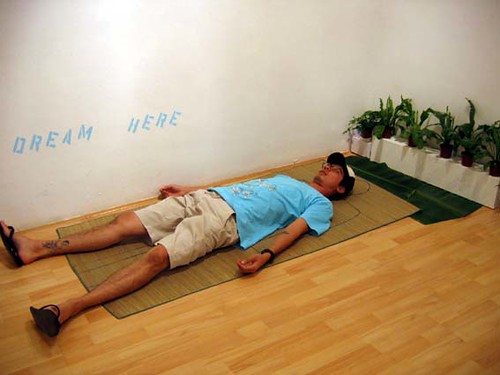The following was written for the exhibition "Check Point" at Mori Gallery, Sydney, which opened on 26 January 2005, (Australia Day aka "Invasion Day"). The event and publication was organised by Zanny Begg. (see my other entry where I have interviewed her about the censorship of her work in Blacktown).
……………..
In 1998, during the 5th Artists’ Regional Exchange (ARX5) in Singapore, Hong Kong Artist Zunzi Wong had his inkjet drawing torn off the walls of the Singapore Art Museum, and stuffed into the museum dumpster. The drawing was a satirical portrait of the then Singapore PM Goh Chok Tong, portrayed as a puppet of “Elder Statesman” Lee Kuan Yew. The cartoon wasn’t particularly incisive or threatening, and simply echoed what Zunzi had been hearing about the leader while on residency in Singapore. But political satire isn’t allowed in that country (or at least wasn’t in 1998), and the museum director, Joanna Lee, suppressed the artwork in order to avoid remonstrance from her superiors in the government ministry. *
Well, that’s my version of the story. At the time, I remember Joanna Lee saying something along the lines of: “We always reserve the right to curate the exhibition, and curating means we can select those pieces which go on show, and this was simply one piece we didn’t happen to choose.” Also, she said the piece breached the contract between artist and museum, which called for “cultural sensitivity” (whatever that means). The museum offered to compensate Zunzi for the cost of making the inkjet prints.
The slippery behaviour of the museum, which (in our comfy liberal view of the world) should be defending the rights of the artist, freedom of speech, etc, has always remained in my memory, attached inextricably to Zunzi’s cartoon. Without that dramatic act of censorship Zunzi’s piece would have just been another bland artwork on the museum walls. But it is impossible to separate the piece from the series of events which followed, including its publication in Art Asia Pacific magazine, and discussion of the issue in various international symposia. The artwork became a kind of provocation for a fascinating social performance, which revealed the limits of acceptable behaviour in Singapore at that time. This was its strength.
Similarly, the inclusion of Zanny Begg’s piece in the [Out of Gallery] exhibition forced the Blacktown Council to “play its hand”. The Council confiscated the spray-stencilled panels, stating that Begg had breached council regulations by placing “illegal signs,” and demanding $400 from the artist to get them back. The “illegal signs” idea is fascinating, and Begg should, in a way, take it as a compliment. So often artists strive to have their projects taken seriously “in the world” – to have their work operate within society as “real politics” – and not as some sort of aestheticised version. Art often gets special treatment – which enables it to exist in the public sphere, but which simultaneously weakens its impact. “Ordinary folks,” when faced with something unusual or challenging, (which isn’t attempting to sell them some product) can relax when they find out “it’s just an artwork”. But Begg’s piece offended somebody within the council (or at least, someone within the council saw the potential that the work might offend somebody else) enough to require censorship.
The role of the curator in this Blacktown schermozzle has been something of a mystery to Begg, and myself, as we have repeatedly tried to get to the bottom of the matter. Adnan Begic, who commissioned the work, went deadly silent as soon as the shit hit the fan, and it was never clear “whose side he was on” – whether he supported the censorship, or opposed it but was silenced by his superiors. What I can say, is that there is certainly a bad feeling left by his inaction – again this idea that the curator should be sticking up for the artist through thick and thin. Perhaps, we thought, he’s not saying anything because he doesn’t want to lose his job – and yet he lost his job anyway. So the worst of both worlds for Begic – no heroics on behalf of the artist, and no job.
Worst of all, the Postwest catalogue, which came out after the event, with documentation of the 38 projects for [Out of Gallery], denied that the censorship had occurred at all.
I do feel anger on behalf of the artist, but I don’t feel sorry for her, because the artwork, as a result of being removed, is having a life far beyond what it might have had otherwise. And, like the Zunzi Wong affair in Singapore, Begg’s work has revealed something essential, somewhat scary, but, by now, not all that surprising – that by suppressing an act of speech, you simply give it more power.
……………….
* In fact, satire in Singapore is allowed, but only under certain conditions: “ although … Minister for Information and the Arts George Yeo mentioned in Parliament in 1995 that political caricatures would be allowed as long as they were done in good taste and without any malicious intentions, the issue of who defines this "good taste'' is raised in the 1998 Zunzi Wong incident at the Singapore Art Museum.” – Lim Cheng Tju, <http://www.singapore-window.org/sw00/000730st.htm>
……………….
update: November 2004, Future of Imagination performance art festival was held in Singapore. Go to the website www.futureofimagination.org and read a review of it in RealTime #65, Feb March 2005, by Alwin Reamillo: www.realtimearts.net
[ps – it could be worth making a connection between these affairs, and the Corridart Affair in Montreal, 1976.]
